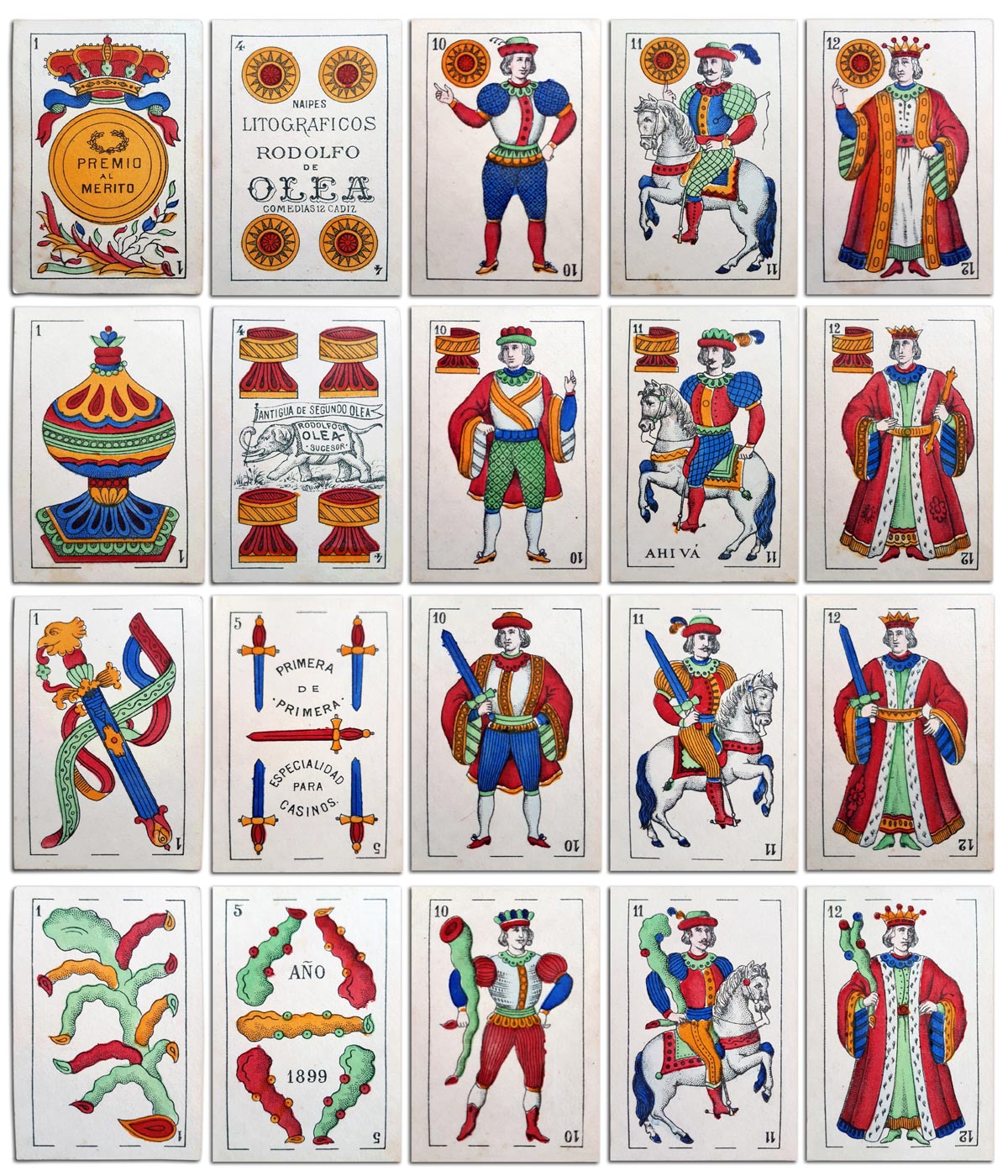Rodolfo de Olea : “El Elefante”
“El Elefante” Cadiz pattern by Rodolfo de Olea Viaña, 1899.
Rodolfo de Olea Viaña (active 1891-1905) inherited a well-established playing card factory from his father, Segundo de Olea Lepiani, in 1891. Inscriptions on the elephant trademark, as well as on other advertising materials, were updated to notify of the succession. The factory address was at Comedias No.12, Cadiz. In around 1895 Rodolfo de Olea commenced using photolithography which produced a finer quality product, although packs continued to be coloured by the older method using stencils.
The Olea playing card factory exported cards around the world, in particular to South American markets, and was awarded numerous gold, silver and bronze medals at exhibitions which are illustrated on several cards.

Above: “El Elefante” deck by Rodolfo de Olea Viaña, Cadiz, dated 1899. This edition was printed by lithography, as stated on the four of coins, but coloured using stencils. All images courtesy Ib Hilmar Hedegaard.
Alternative presentation



Towards the end of the 18th century, with the rise of industrialisation, the need for a more powerful source of energy was felt. Steam engines provided the answer, and were employed in playing card manufacture even into the early 20th century.

Above: interior view of the Olea playing card factory showing steam-powered presses and workers engaged in the various stages of manufacture, late 19th century. © El Fenicio, 2015.
Rodolfo de Olea’s son, Rodolfo de Olea Mora (1874-1926) and his step-brother Segundo de Olea Aguilera (1893-c.1950) also manufactured playing cards. See: Segundo de Olea Aguilera►

Above: other members of the extended family were also card makers.
REFERENCES
Pérez González, Alberto: Los Naipes de Cádiz, in LA SOTA no.13, Asescoin, Madrid, October 1995
Portillo, Jose Alvarez: La fábrica de cartas e imprenta Olea, in El Fenicio, Cadiz, December 26th, 2015 (www.elfenicio.com)

By Simon Wintle
Member since February 01, 1996
I am the founder of The World of Playing Cards (est. 1996), a website dedicated to the history, artistry and cultural significance of playing cards and tarot. Over the years I have researched various areas of the subject, acquired and traded collections and contributed as a committee member of the IPCS and graphics editor of The Playing-Card journal. Having lived in Chile, England, Wales, and now Spain, these experiences have shaped my work and passion for playing cards. Amongst my achievements is producing a limited-edition replica of a 17th-century English pack using woodblocks and stencils—a labour of love. Today, the World of Playing Cards is a global collaborative project, with my son Adam serving as the technical driving force behind its development. His innovative efforts have helped shape the site into the thriving hub it is today. You are warmly invited to become a contributor and share your enthusiasm.
Related Articles

Pierre Varangot
Tracing the origins, legality and legacy of Pierre Varangot’s San Sebastián deck.

Archaic Spanish-suited pattern from Bayonne
Archaic Franco-Spanish pattern from Bayonne by a manufacturer with the initals M.V.

Tarot de las Coscojas
Historical playing card design, tarot symbolism and an almost psychedelic medieval surrealism.

Tarot de Valverde de la Vera
A series of 24 surrealist engravings by Mexican artist Claudio Favier in which archetypal Tarot alle...

Baraja de Juan Martín Zamorano
Deck inspired by El Pendón de los Zamorano, a military pennant dating from 1501, published by Priego...

Heráldica Castanyer No. 16
Strange variant of international pattern cards for poker or bridge.

Fantasy Spanish-suited deck
Fantasy Spanish-suited deck by Bertschinger y Codina, Barcelona.

Bertschinger y Codina - Cartes Françaises
French ‘Paris’ pattern made by Bertschinger y Codina, Barcelona, c.1850.

Braulio Fournier
Baraja Nº 1 produced by Braulio Fournier, Burgos, c.1868.

Pirritx eta Porrotx
Happy Families card game from the Spanish Basque Country.

Naipe Vizcaino
‘Naipe Vizcaino’ designed by Javier Urkiri and published by Industrias Gráficas Castuera and the Caj...

Baraja Turística del País Vasco
Basque poker deck of 55 cards published by Fournier with scenic views of the Basque Country.

Baraja Vasca
Spanish Basque Country deck with original drawings by María Isabel Ibañez de Sendadiano.

Baraja Cultura Española
ASESCOIN pack for 2022 designed by M.A. Corella featuring famous Spaniards and notable buildings.

Laurenzo Propagine
Spanish-suited cards made in Italy by Laurenzo Propagine.

Jeu de 7 familles Les Dynasties d’Artisans Basques
Long-standing Basque businesses represented in a traditional card game with illustrations by Odile A...
Most Popular
Our top articles from the past 28 days





